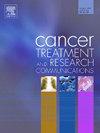Impact of adjuvant therapy on survival in treatment of CNS hemangiopericytomas
IF 2.4
Q3 Medicine
引用次数: 0
Abstract
Introduction
Central nervous system (CNS) Hemangiopericytoma is a rare tumor which account for <0.5% of all CNS tumors. The purpose of this study was to assess the clinical outcomes and the impact of adjuvant treatment on survival.
Materials/ Methods
A total of 64 patients histo-pathologically diagnosed as CNS Hemangiopericytoma, treated between 2000 and 2018 with or without adjuvant radiation and chemotherapy, were evaluated for the various survival parameters. Kaplan Meier method was utilized for assessment of the survival outcomes. Treatment and demographic parameters were assessed as prognostic factors for the survival outcomes using Multivariate analysis. The patients were followed up as per the institution protocol.
Results
The median follow-up was 50.6 months (range: 8–158 months). The median age was 40 years (range: 8–63 years), with 44 male and 20 female patients. Headache was the most common symptom (46 patients, 71.8%), followed by visual disturbances (18 patients, 28.1%). Tumors were primarily supratentorial (50 patients, 78.1%), with a median diameter of 5 cm (range: 2–7.6 cm). Gross total resection (GTR) was achieved in 40 patients (62.5%). Of the cohort, 34 patients (53.1%) had WHO grade II tumors, and 30 (46.9%) had grade III tumors. Radiation therapy was administered to 54 patients (84.4%) with a median dose of 60 Gy (range: 40–60 Gy), and 8 patients (12.5%) received stereotactic radiation therapy (median: 16.1 Gy). Adjuvant chemotherapy (ifosfamide and epirubicin-based) was given to 40 patients (62.5%). Recurrence occurred in 31 patients (48.4%), with 24 patients (37.5%) experiencing local recurrence and 7 patients (10.9%) developing distant metastases. The median recurrence-free survival (RFS) was 38.4 months, and the median overall survival (OS) was 44 months. Multivariate analysis showed that radiation therapy (p = 0.012), chemotherapy (p < 0.001), and GTR (p = 0.023) significantly reduced recurrence risk.
Conclusion
Even though CNS Hemangiopericytoma is a rare disease entity, local and distant recurrences are a cause of concern and require evaluation of role of adjuvant therapy. Our study shows that complete excision followed by adjuvant therapy in the form of radiation therapy and chemotherapy improves the survival in CNS Hemangiopericytoma. Besides the prognostic factors assessed, there is a need for larger prospective study to improve the treatment outcomes.
辅助治疗对中枢神经系统血管外皮细胞瘤生存期的影响
中枢神经系统(CNS)血管外皮细胞瘤是一种罕见的肿瘤,占所有中枢神经系统肿瘤的0.5%。本研究的目的是评估临床结果和辅助治疗对生存的影响。材料/方法对64例经组织病理学诊断为中枢神经系统血管外皮细胞瘤的患者进行各种生存参数的评估,这些患者在2000年至2018年期间接受了或未接受辅助放化疗。采用Kaplan Meier法评估生存结果。使用多变量分析评估治疗和人口统计学参数作为生存结果的预后因素。按照医院的方案对患者进行随访。结果中位随访时间为50.6个月(8 ~ 158个月)。中位年龄40岁(范围8-63岁),男44例,女20例。头痛是最常见的症状(46例,71.8%),其次是视力障碍(18例,28.1%)。肿瘤主要位于幕上(50例,78.1%),中位直径为5cm(范围:2-7.6 cm)。40例(62.5%)患者全部切除。在该队列中,34例患者(53.1%)为WHO II级肿瘤,30例患者(46.9%)为WHO III级肿瘤。54例患者(84.4%)接受放射治疗,中位剂量为60 Gy(范围:40-60 Gy), 8例患者(12.5%)接受立体定向放射治疗(中位剂量:16.1 Gy)。辅助化疗(以异环磷酰胺和表柔比星为基础)40例(62.5%)。复发31例(48.4%),局部复发24例(37.5%),远处转移7例(10.9%)。中位无复发生存(RFS)为38.4个月,中位总生存(OS)为44个月。多因素分析显示放疗(p = 0.012)、化疗(p < 0.001)和GTR (p = 0.023)显著降低复发风险。结论尽管中枢神经系统血管外皮细胞瘤是一种罕见的疾病,但局部和远处复发是一个值得关注的问题,需要评估辅助治疗的作用。我们的研究表明,完全切除后辅以放疗和化疗的辅助治疗可提高中枢神经系统血管外皮细胞瘤的生存率。除了评估预后因素外,还需要更大规模的前瞻性研究来改善治疗结果。
本文章由计算机程序翻译,如有差异,请以英文原文为准。
求助全文
约1分钟内获得全文
求助全文
来源期刊

Cancer treatment and research communications
Medicine-Oncology
CiteScore
4.30
自引率
0.00%
发文量
148
审稿时长
56 days
期刊介绍:
Cancer Treatment and Research Communications is an international peer-reviewed publication dedicated to providing comprehensive basic, translational, and clinical oncology research. The journal is devoted to articles on detection, diagnosis, prevention, policy, and treatment of cancer and provides a global forum for the nurturing and development of future generations of oncology scientists. Cancer Treatment and Research Communications publishes comprehensive reviews and original studies describing various aspects of basic through clinical research of all tumor types. The journal also accepts clinical studies in oncology, with an emphasis on prospective early phase clinical trials. Specific areas of interest include basic, translational, and clinical research and mechanistic approaches; cancer biology; molecular carcinogenesis; genetics and genomics; stem cell and developmental biology; immunology; molecular and cellular oncology; systems biology; drug sensitivity and resistance; gene and antisense therapy; pathology, markers, and prognostic indicators; chemoprevention strategies; multimodality therapy; cancer policy; and integration of various approaches. Our mission is to be the premier source of relevant information through promoting excellence in research and facilitating the timely translation of that science to health care and clinical practice.
 求助内容:
求助内容: 应助结果提醒方式:
应助结果提醒方式:


